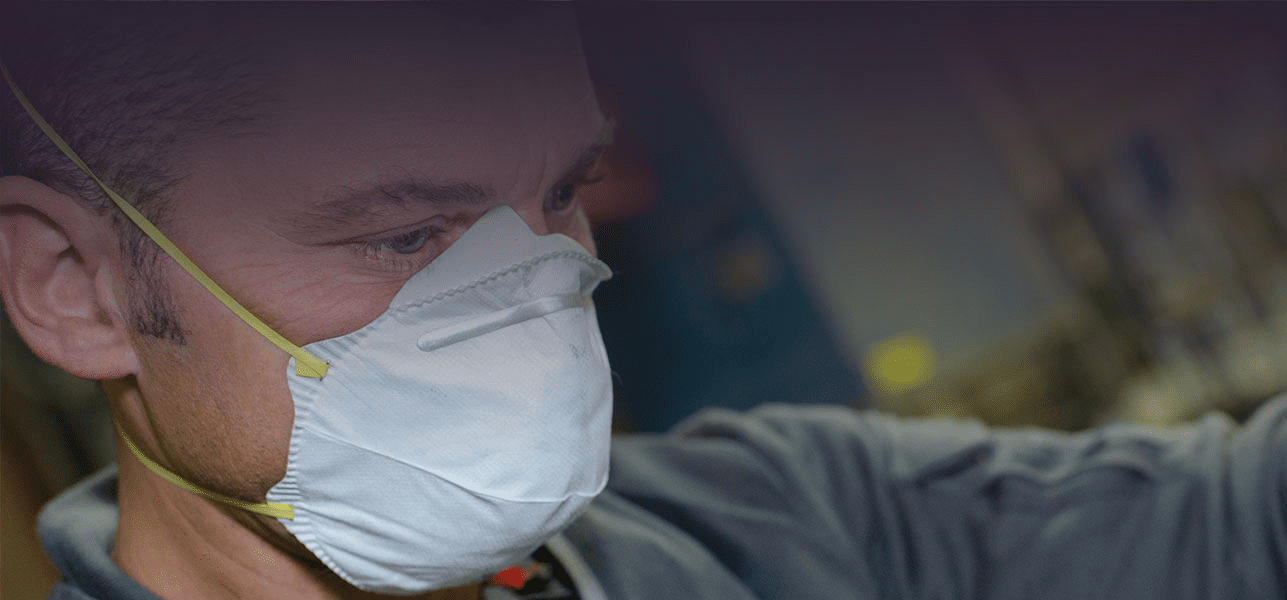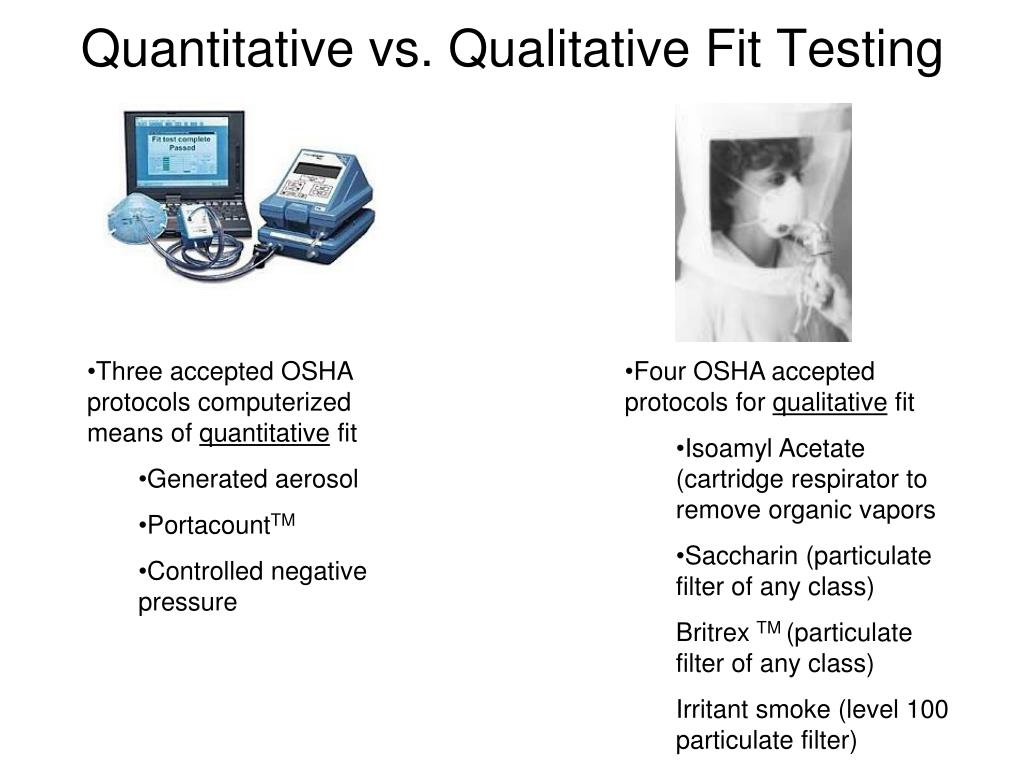Qualitative vs quantitative fit test
Home » Free Imaging » Qualitative vs quantitative fit testQualitative vs quantitative fit test
Qualitative Vs Quantitative Fit Test. There are multiple ways to break down the differences between Qualitative fit testing and Quantitative fit testing. Quantitative fit testing can be used for any type of tight-fitting respirator and involves a machine that is used to measure the amount of leakage into the face piece. There are two Fit Test methods these are known as. Quantitative Fit Testing QNFT and Qualitative Fit Testing QLFT QLFT is a low cost subjective passfail test that exposes the respirator wearer to a chemical stimulant while donning a test hood that can.
 How Well Does The Face Piece Seal To The Persons Face What Is Fit Testing About Determining If A Specific Respirator Fits To A Persons Face All Respirators Ppt Download From slideplayer.com
How Well Does The Face Piece Seal To The Persons Face What Is Fit Testing About Determining If A Specific Respirator Fits To A Persons Face All Respirators Ppt Download From slideplayer.com
Quantitative Fit Testing QNTF Unlike the qualitative test the quantitative test relies on a machine that attaches to the respirator via a tube to measure any leakage. The quality of the test relies on the competency of each fit test administrator. Quantitative Fit Testing QNFT and Qualitative Fit Testing QLFT QLFT is a low cost subjective passfail test that exposes the respirator wearer to a chemical stimulant while donning a test hood that can. Two basic types of fit tests. Its usually used when testing half-mask respirators that cover your nose and mouth such as filtering facepiece respirators N95. OSHA accepts three quantitative fit test methods.
OSHA accepts three quantitative fit test methods.
Uses sense of tastesmell or reaction to irritant to detect leaks. Two common fit-test methods can be employed. Quantitative Face Fit Testing The process of quantitative face fit testing is quite different. This video briefly discussed the difference between quantitative face fit testing and qualitative face fit testing. Respirator fit tests are either qualitative or quantitative. In this scenario the respirators face piece is attached to a probe that is connected to the machine by a hose.
 Source: slidetodoc.com
Source: slidetodoc.com
There are advantages and disadvantages to qualitative and quantitative fit testing. Quantitative is data-based provides a real objective metric and usually tests the actual mask individuals will wear to protect them. Quantitative QNFT and qualitative QLFT. Quantitative and Qualitative tests. The Quantitative PortaCount method can be used to fit test all types of tight-fitting masks including disposable half and full face masks.
Source: tsi.com
In qualitative fit testing the testing is done. Med Compass will only test our fire departments in a Quantitative method. Quantitative fit testing can be used for any type of tight-fitting respirator and involves a machine that is used to measure the amount of leakage into the face piece. Respirator fit-testing is required prior to use to ensure that the selected respirator provides an adequate face seal. There are two Fit Test methods these are known as.
 Source: semanticscholar.org
Source: semanticscholar.org
RPA can provide both Qualitative and Quantitative PortaCount tests on-site throughout the UK. Qualitative Fit Testing is simply a pass or fail test that uses your sense of smell or taste or your reaction to a known irritant. Respirator fit tests are either qualitative or quantitative. Respiratory protection standards deem both fit-tests to be acceptable. It does not measure the leakage into or.
 Source: trainingandtestingservices.co.uk
Source: trainingandtestingservices.co.uk
If youre testing a full-face respirator the quantitative fit test is recommended instead. An unsuccessful qualitative fit test QLFT or quantitative fit test QNFT would indicate that the respirator has not achieved a good facepiece-to-face seal for the worker being tested and the respirator would therefore be expected to deliver less protection than the APF it was assigned in Table 1. Two common fit-test methods can be employed. If youre testing a full-face respirator the quantitative fit test is recommended instead. Quantitative Fit Testing QNFT and Qualitative Fit Testing QLFT QLFT is a low cost subjective passfail test that exposes the respirator wearer to a chemical stimulant while donning a test hood that can.
 Source: link2life.ca
Source: link2life.ca
There are advantages and disadvantages to qualitative and quantitative fit testing. Quantitative Fit Testing QNTF Unlike the qualitative test the quantitative test relies on a machine that attaches to the respirator via a tube to measure any leakage. Two basic types of fit tests. There are advantages and disadvantages to qualitative and quantitative fit testing. Med Compass believes that fire de-partments are taking an unneeded li-ability using the Qualitative fit testing method.
 Source: xosafety.com
Source: xosafety.com
A quantitative fit test assesses respirator fit by numerically measuring leakage into the respirator. Fit test administrators may. Qualitative fit testing is a passfail method used on half-masks that relies on senses - such as taste and smell - to detect air leakage from your respirator. Respirator fit tests are either qualitative or quantitative. Quantitative fit testing can be used for any type of tight-fitting respirator and involves a machine that is used to measure the amount of leakage into the face piece.
 Source: face-fit.co.uk
Source: face-fit.co.uk
There are advantages and disadvantages to qualitative and quantitative fit testing. It does not measure the leakage into or. The main difference between quantitative mask fit testing and qualitative mask fit testing is that quantitative testing objectively measures the amount of leakage quantity while qualitative testing relies subjectively on the users taste and smell to detect leakage. Respirator fit tests are either qualitative or quantitative. OSHA accepts three quantitative fit test methods.
 Source: slideplayer.com
Source: slideplayer.com
For all positive pressure atmosphere-supplying respirators either qualitative or quantitative fit testing may be used. Qualitative fit testing is a subjective passfail test method. Two common fit-test methods can be employed. When quantitative fit-testing is used all full-facepiece respirators must meet or exceed a fit factor of 500 while quarter- and half-mask respirators must meet or exceed 100. There are two main types of respirator fit tests.
 Source: vpppa.org
Source: vpppa.org
There are two main types of respirator fit tests. Quantitative Fit Testing QNFT and Qualitative Fit Testing QLFT QLFT is a low cost subjective passfail test that exposes the respirator wearer to a chemical stimulant while donning a test hood that can. There are two different methods of respirator fit testing. There are two main types of respirator fit tests. If youre testing a full-face respirator the quantitative fit test is recommended instead.
 Source: slideserve.com
Source: slideserve.com
It doesnt measure the amount of leakage into your respirator it will just let you know there is a leak present. OSHA accepts three quantitative fit test methods. There are two main types of respirator fit tests. Two basic types of fit tests. Two common fit-test methods can be employed.
 Source: safetysolutions.net.au
Source: safetysolutions.net.au
Quantitative Respirator Fit Test. There are two main types of respirator fit tests. There are two Fit Test methods these are known as. Qualitative fit-test QLFT or quantitative fit-test QNFT. In qualitative fit testing the testing is done.
 Source: blog.prochoice.com.au
Source: blog.prochoice.com.au
There are two Fit Test methods these are known as. RPA can provide both Qualitative and Quantitative PortaCount tests on-site throughout the UK. There are advantages and disadvantages to qualitative and quantitative fit testing. Fitting face pieces now be tested with a Quantitative Fit Test QNFT instead of the previously-approved Qualitative Fit Test QLFT. Qualitative fit testing is a passfail test to assess respirator fit based on the individuals response to a test agent.
Source: tsi.com
Two basic types of fit tests. Respirator fit tests are either qualitative or quantitative. Uses sense of tastesmell or reaction to irritant to detect leaks. Quantitative QNFT and qualitative QLFT. Fit Testing Quantitative Tests.
 Source: mit-tec.com
Source: mit-tec.com
Quantitative is data-based provides a real objective metric and usually tests the actual mask individuals will wear to protect them. Qualitative fit-test QLFT or quantitative fit-test QNFT. Unlike qualitative methods this type of testing isnt reliant on the person and uses methods such as particle counting to effectively measure the quality of the seal. A quantitative fit test assesses respirator fit by numerically measuring leakage into the respirator. Its usually used when testing half-mask respirators that cover your nose and mouth such as filtering facepiece respirators N95.
Source: tsi.com
Fit test administrators may. Fit Testing Quantitative Tests. Its usually used when testing half-mask respirators that cover your nose and mouth such as filtering facepiece respirators N95. Qualitative fit testing is a subjective passfail test method. Quantitative Respirator Fit Test.
If you find this site beneficial, please support us by sharing this posts to your favorite social media accounts like Facebook, Instagram and so on or you can also bookmark this blog page with the title qualitative vs quantitative fit test by using Ctrl + D for devices a laptop with a Windows operating system or Command + D for laptops with an Apple operating system. If you use a smartphone, you can also use the drawer menu of the browser you are using. Whether it’s a Windows, Mac, iOS or Android operating system, you will still be able to bookmark this website.
